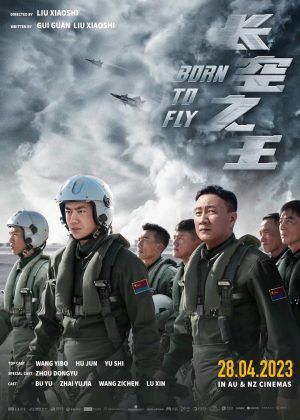Sribala Subramanian

A fighter jet skims low over the water and shoots past an off-shore drilling platform. A voice crackles over the radio: “You have entered China’s air defense identification zone.” The pilot of the intruding aircraft replies in American-accented English: “We can come and go whenever we want.” The stealth fighter goes full throttle, and a sonic boom shatters the windows of a coast guard boat nearby. Chinese Air Force jets chase after the intruder. But their planes cannot match the foreign army’s pyrotechnics.
The action film “Born to Fly” opens with a white-knuckle dog fight scene in a maritime setting. But where does the action take place? Journalist David Rennie, who watched the film in Beijing, said there are clues in every frame. “If you look at the fact that there’s a gas platform. If you look at the straw conical hats the fishermen are wearing, the best guess is the South China Sea,” The Economist’s Beijing bureau chief told the podcast “Drum Tower.”
The setting hints at conflicts to come. But Rennie feels the more unnerving aspect of the film lies in the dialogue, specifically the line: “We can come and go whenever we want.” At the end of the sequence, a Chinese Air Force officer voices his anguish over the nation’s humiliation at the hands of a “foreign army” whose advanced stealth fighters are “invading our jurisdiction of the sea.” The implication that “hostile” military aircraft are breaching sovereign airspace, Rennie argues, opens up “a geopolitical can of worms.”
The South China Sea is a contentious space. China claims a wide swath of the marine region. But some islands under China’s control are disputed territories claimed by neighboring countries like Vietnam, Malaysia, or the Philippines. The U.S. is not a party to territorial disputes but has clashed with China over the right of transit through international airspace and waterways.
Last month, a U.S. Air Force plane had an unusually close encounter with a Chinese stealth fighter jet. A video of the incident shows the American pilot jolted by turbulence from the wake of the J-16, which flew directly in front of the nose of the RC-135, a reconnaissance aircraft. On May 30, the U.S. Indo-Pacific Command put out a statement calling the maneuver “aggressive.” The reconnaissance plane, they maintained, “was conducting safe and routine operations over the South China Sea in international airspace, in accordance with international law.”
On the same day, China’s president made a notable speech on national security peppered with maritime metaphors. “We must be prepared for worst-case and extreme scenarios, and be ready to withstand the major test of high winds, choppy waters, and even dangerous storms,” said Xi Jinping. A week later, inspecting troops in Inner Mongolia, he called on the army to “forge the Great Wall of Steel to defend the country and defend the border.”
“Born to Fly” mirrors the shift in the national mood. In The Economist’s podcast, Rennie points out that the film’s theme of China as the underdog in a confrontation with the U.S. evokes “Maoist era vibes of a country under siege.” But there’s a contemporary twist. A technological blockade by unnamed powerful countries has hampered the nation’s ability to develop the next generation of stealth fighters. Despite these constraints, the aviation industry doubles down and builds the J-20, an advanced fighter jet just as powerful as the warplanes of the “hostile forces.”
An eagerness to portray the military in the best light may have contributed to some pre-release jitters. A debut set for September 30, 2022, was abruptly scrubbed without explanation. The Chinese Air Force was reportedly disappointed with the movie’s stunts and special effects. The script also contained a few cringe-worthy errors: the fifth-generation J-20 was called a fourth generation stealth fighter jet.
When “Born to Fly” was finally released in May, the film soared to the top of the box office charts in China. Global Times raved about the “thrilling dogfight scenes” and praised the moviemakers for highlighting the “spiritual” bond between the young test pilots and an older generation of aviation pioneers. The state-owned publication contrasted their selfless patriotism with the self-absorption of the Hollywood air combat hero who chases after personal glory.
Outside China, the response was lukewarm. Critics dismissed the film as a second-rate “Top Gun: Maverick.” But evaluating the film on production values alone overlooks the underlying message. “Born to Fly” could well be a preview of “extreme scenarios” yet to unfold.
No comments:
Post a Comment